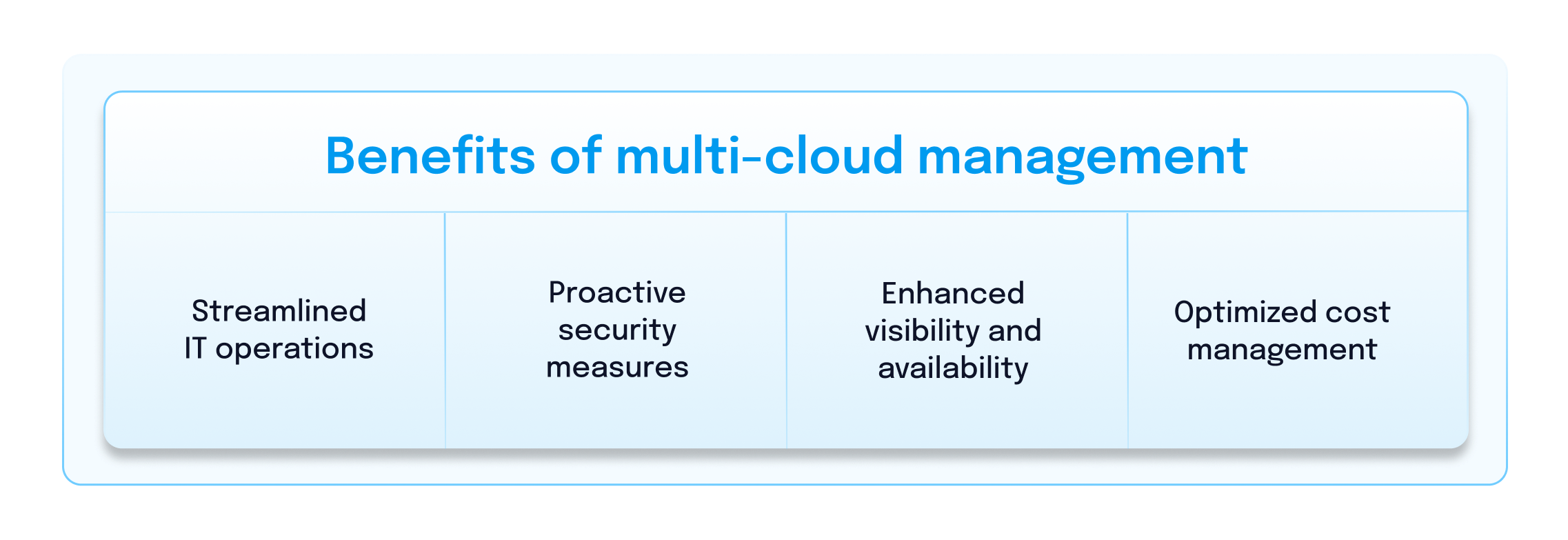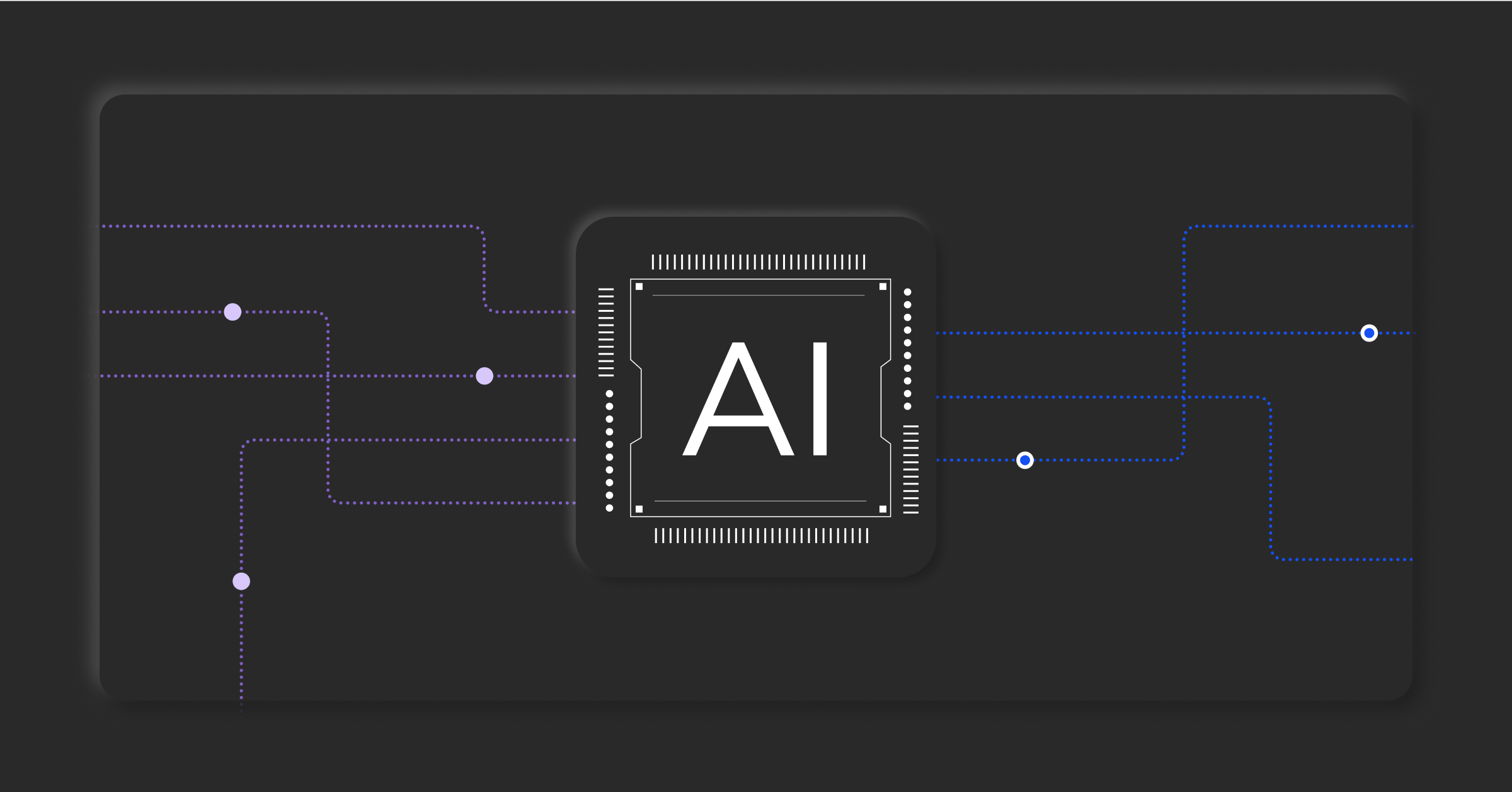What is a multi-cloud management platform?

As an IT leader, you’re acutely aware of the struggles of juggling multiple cloud environments, from integration headaches to holistic incident management to monitoring multiple clouds at once. Seeking a more efficient multi-cloud management solution is crucial to alleviate these pressures and streamline your cloud operations.
Using a multi-cloud management platform is crucial for managing resources across different cloud services to maximize performance, improve cost-effectiveness, and ensure full-stack visibility across your diverse cloud environment.
Cloud management isn’t easy, but we’ll make understanding it as simple as possible in this blog.
Let’s explore multi-cloud management, from the very basics of multi-cloud management to how AIOps can automate and improve visibility across your clouds. Read on to learn:
- What is multi-cloud management?
- Benefits of multi-cloud management
- Common challenges of multi-cloud management
- What is a multi-cloud management platform?
- Key features of an effective multi-cloud management system
- Understanding AIOps as a solution for multi-cloud management
- Master your cloud visibility with BigPanda AIOps
What is multi-cloud management?
Multi-cloud management refers to the comprehensive tools, processes, and strategies organizations use to monitor and optimize applications and workloads across multiple cloud environments.
Multi-cloud management aims to streamline disparate cloud infrastructure management, connectivity, and observability, allowing for centralized control and improved operational efficiency. Multi-cloud management tools act as control centers where IT teams can manage everything from one place, even using different cloud platforms like Google Cloud, AWS, or Azure.
This facilitates a cohesive and integrated approach to managing resources, ensuring full visibility, and optimizing performance within a multi-cloud deployment.
Benefits of multi-cloud management
Multi-cloud management offers enhanced flexibility and risk mitigation, allowing businesses to optimize performance and cost-efficiency by leveraging the strengths of different cloud providers. It also fosters innovation and agility, enabling organizations to rapidly adapt to changing market demands and technological advancements.
- Streamlined IT operations: With a simplified, centralized management approach, multi-cloud management helps alleviate the strain on IT teams. It empowers you to navigate and manage applications seamlessly across diverse cloud landscapes, ensuring an efficient and cohesive operational workflow. You’ll want to ensure that your management solution can or integrates with tools that can automate incident detection and response, reducing manual intervention.
- Enhanced visibility and availability: A proficient multi-cloud management solution is a lifesaver for ITOps and DevOps teams juggling multiple cloud providers. It provides unparalleled visibility, offering a comprehensive view of the entire multi-cloud environment. This transparency is crucial for informed decision-making and maximizing the benefits of a multi-cloud strategy.
- Optimized cost management: While the allure of discounts from different cloud providers drives businesses toward a multi-cloud strategy, managing costs in such environments can be overwhelming. Multi-cloud management offers meticulous tracking of costs and usage. Moreover, advanced platforms can use intelligent data analysis to understand tool usage and optimize cost management, improving financial efficiency in a complex multi-cloud landscape.

Common challenges of multi-cloud management
Managing multiple cloud environments introduces complexity in integration, data management, and consistent security policies, requiring sophisticated coordination and expertise. Additionally, it can lead to increased costs and resource demands, as each cloud platform may have its unique management tools and operational nuances.
- Complex and diverse technologies: Managing multiple cloud service providers involves different interfaces, APIs, and tools. Each cloud provider has its own features, making maintaining consistency and a unified management approach challenging. Also, IT teams will likely need expertise in multiple cloud technologies, which may not align with their existing skill sets.
- Security concerns: When cloud providers have different security models, compliance standards, and access controls, top-notch security becomes increasingly complicated. Teams need to ensure consistent security policies and monitoring across different clouds to mitigate risks.
- Cost management and optimization: Implementing a multi-cloud strategy brings cost challenges. Issues such as underutilized cloud resources across multiple providers and data egress fees for transferring data between clouds can add up. The heightened complexity of multi-cloud environments further raises the risk of downtime. Cost optimization requires a comprehensive strategy and multi-cloud management tools that work across different platforms.
- Hybrid cloud complexity: Managing hybrid cloud stacks requires smooth integration and coordination between on-premises and cloud environments. For this, you’ll need operational insights and incident management that spans across your hybrid environments. Without a unified approach, there’s a higher risk of outages and disruptions in cloud operations and difficulties optimizing workloads.
- Performance monitoring: Seamless monitoring between multiple cloud providers is complex due to differences in data formats and storage systems. Look for solutions enabling better monitoring, observability, and performance management. Improved availability and cost-effectiveness requires a unified approach, especially for organizations with hybrid cloud setups.
- Governance and compliance: Organizations need to navigate various regulatory requirements and adhere to internal policies. Unencrypted storage buckets or unmonitored cloud VMs can lead to serious data leakages if undetected, risking non-compliance. To address these issues, vigilant monitoring, incident management, and timely intervention become crucial to prevent potential compromises.
What is a multi-cloud management platform?
A multi-cloud management platform is a centralized tool that streamlines the management of applications and data spread across different cloud providers. It acts as a control center, offering a unified view to monitor, optimize, and secure resources.
In a hybrid setting, a multi-cloud management platform enables seamless coordination between on-premises data centers and multiple private and public cloud providers. It ensures a consistent approach to resource management, enforcing unified security, compliance, and governance policies. The platform facilitates smooth data and application mobility, allowing businesses to move workloads between on-premises and cloud environments, optimizing IT operations.
Key features of an effective multi-cloud management system
Understanding the features of an effective multi-cloud management system is key to ensuring seamless integration, security, and optimal performance across your diverse cloud environments. These include:
- Service provisioning: Ensure the multi-cloud management platform quickly launches and allocates cloud services on demand. It should seamlessly translate provisioning requests from the console or API into the targeted cloud’s native API within the multi-cloud architecture, offering users optimal services.
- Service monitoring: Look for a platform that can measure and visualize application and network performances across the hybrid cloud, public cloud, and private cloud services. Comprehensive reporting should include insights into service reliability, cost metrics, and occurrences for future planning.
- Service performance: An effective multi-cloud management system monitors service performance and logs relevant data. In cases of underperforming services, the platform should support blacklisting until issues are resolved, aiding in effective service prioritization.
- Service governance/policy: Seek functionality for defining and leveraging policies around service use and execution. This feature informs decision-making on service selection and application suitability within the multi-cloud environment, serving as an audit for service governance.
- Service orchestration: Opt for a system capable of orchestrating cloud services to meet specific business application or process needs. This ensures that diverse service requirements, such as those for an eCommerce or trading application, can be effectively addressed.
- Robust analytics: Prioritize tools that offer comprehensive cloud behavior analysis, providing key metrics and predictive insights for informed decision-making based on deep data.
Understanding AIOps as a solution for multi-cloud management
AIOps is the intelligent backbone to transform overwhelming alert noise and alert fatigue across multi-cloud management into a first pane of glass that delivers streamlined, proactive, and efficient incident management operations.
Its forte lies in intelligent automation and advanced analytics in multi-cloud management across various cloud platforms, facilitating swift, informed decision-making. AIOps provides a consolidated, unified view of all cloud services, providing continuous insight into the performance and availability of applications and services across multi-cloud infrastructures. This unified perspective simplifies the inherent complexities of multi-cloud setups, ensuring a streamlined and efficient incident management process.
Beyond monitoring, AIOps creates correlation patterns based on the alerts received to easily understand the interdependencies of alerts across your shared multi-cloud infrastructure. This provides early detection of forming incidents to shorten and automate incident triage. Automating more of your incident management is pivotal in minimizing downtime and addressing emerging incidents in real-time. A focus on efficient resource management enhances system performance, while continuous system-wide monitoring ensures high availability across the cloud ecosystem.
In addition, AIOps seamlessly ingests event and alert data from various cloud monitoring and observability services to minimize errors and streamline downstream incident response processes. Its adaptability and scalability enable tailored evolution alongside the dynamic needs of multi-cloud environments, serving as the cornerstone of intelligent, forward-thinking operations.

Master your cloud visibility with BigPanda AIOps
BigPanda AIOps stands out as a robust solution for multi-cloud management, uniquely designed to tackle the complexities of modern IT environments. It automates various aspects of the incident management lifecycle, allowing IT Operations teams to scale efficiently and manage the increased load from new digital services and offerings.
With its SaaS-native, microservices-based platform architecture, BigPanda ensures effortless system scaling, seamlessly handling spikes in data volumes, making it ideal for dynamic multi-cloud environments. The platform’s high-reliability guarantees and enterprise-grade security ensure 24/7 operational integrity, crucial for businesses operating across multiple cloud services. With the enterprise cloud capacities of BigPanda, you’re ensured:
- Effortless system scaling
- No downtime for upgrades and enhancements
- High-reliability guarantees
- Lower cost of ownership
- Enterprise-grade security
Additionally, BigPanda supports digital transformation initiatives by catering to modern environments that include hybrid stacks, Kubernetes, and microservices-based apps.
This comprehensive support allows teams to innovate and transform without the negative effects typically associated with complex multi-cloud management. Experience the transformation first hand through a personalized demo and see for yourself how BigPanda is a pivotal tool in driving digital transformation in multi-cloud setups.




